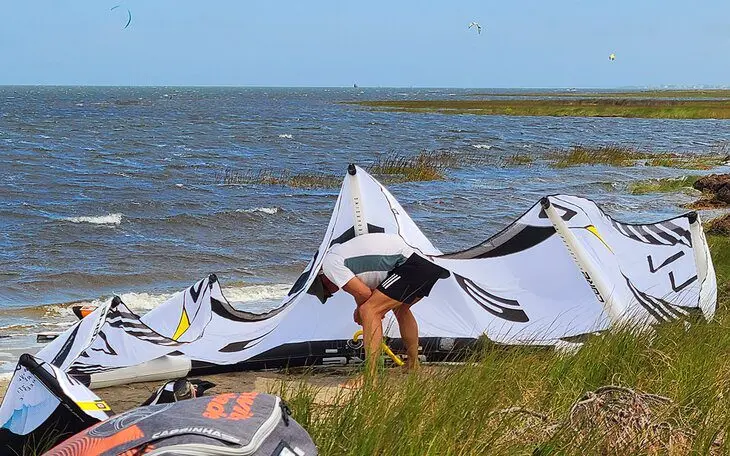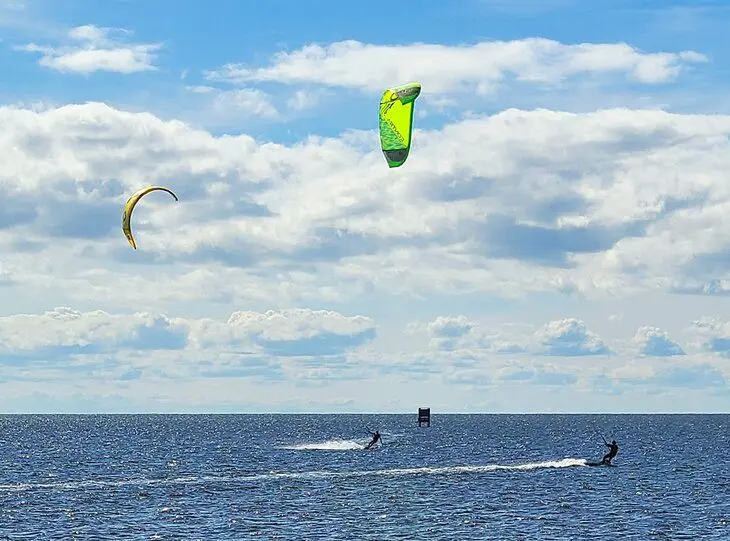Contents
The Outer Banks of North Carolina, also known as OBX, is considered one of the top destinations in the USA for this thrilling water sport. With its vast stretches of beaches, shallow and calm waters, and top-notch accommodations, OBX is the perfect place for kiting enthusiasts to indulge in their passion.
I learned to kiteboard in the tumultuous waters of Cabarete, Dominican Republic, where the waves were towering and the sea was packed with other kiteboarders. Flat water is not a concept there. So, when I arrived at Pamlico Sound in the Outer Banks for the first time, I was amazed by the progress I made on the shallow and vast flat waters. Not only did I improve, but I also found the experience more exhilarating and easier on my body.

The Outer Banks are a place all their own. Something changes when you cross the long bridges over empty expanses of water onto these narrow slivers of sand. The Outer Banks echo with the whispers of old pirate legends, brim with untamed natural beauty, and offer an unmatched laid-back coastal charm.
With steady breezes and 200 miles of beaches on both the Atlantic Ocean and Pamlico Sound, it’s no surprise that wind sport enthusiasts have been coming here for years. It all started with the windsurfers in the 1980s and then, as kiteboarding became more popular, it transitioned to kiteboarders, the people you now see out on the water.
Today, the Outer Banks are peppered with beach towns known for their ideal kiteboarding conditions. Some, like Salvo, Waves, Rodanthe, and Hattaras, are packed with amenities, from hotels and kite shops to restaurants and beachwear stores. Other places, like Ocracoke, are much more remote but offer incredible conditions for those willing to make the trek.
Kiteboarding locations with names like Wash Out, Real Slicks, Kite Point, Buxton Flats, D Spot, SDU, and the ever-evocative Planet of the Apes grab at your imagination and won’t let go.
Where to Stay for the Best Kiting

So how do you plan a kiteboarding trip to the Outer Banks? The first step is figuring out your home base.
A big advantage of kiteboarding season in the Outer Banks is that the best months for this sport fall in the shoulder season, making prime accommodations easy to find at a lower price.
Most kiters tend to stay in either the Tri-villages of Rodanthe/Waves/Salvo or in Avon. My favorite is Avon, which puts you pretty much in the dead center of the best spots, has the greatest accommodation options, a bit of nightlife, and support services like grocery stores and kite shops.
The type of accommodation you need depends on the size of your group. During my most recent trip, I traveled with 15 of my kiting friends. We decided to rent two large homes on stilts, each with 6-10 bedrooms and ensuite bathrooms. The homes were equipped with huge outdoor decks, pools, hot tubs, and well-stocked kitchens. It was easy to rent these homes through a local rental company, in our case, we used Surf or Sound.
If you are a smaller group, accommodation is available waterfront at the Waterman’s Retreat at Real Watersports or Waves Village Kitty Hawk Kites Kiteboarding Resort. For those budget kiters who are pinching every penny and living out of a van, private campgrounds are available in prime locations, and national park campgrounds are also an option but are a fair distance away.
Transport is important, unless you score a house with a launching area out front, you’ll need to drive each day to the launch sites. Take it from me, rent an SUV so you can easily throw all your gear in the back after a long day on the water.
The Best Season for Kiteboarding in the Outer Banks

The key to having an incredible kiting trip to the Outer Banks is choosing the right time to go. The OBX kiteboarding season runs from April through to October with spring and fall having the best conditions. You’ll find that southern winds dominate in the warmer months and as fall approaches, they swing around to the northeast.
In the spring, a light wetsuit is required as the water is still cool, in the fall you’ll be fine in board shorts or a bathing suit unless it’s cloudy, then a light wetsuit is handy.
The Equipment

A wide range of kites is important, if you are coming for a week count on winds ranging from 12-25 knots and a few days where the wind isn’t suitable except for those who enjoy foiling. On my most recent seven-day trip I was twin tipping and brought a 7, 9, 11, and 13.5 meter quiver of CORE kites and used every one of them.
If you are looking for additional equipment or feel the need for a new kite or two, both Real Watersports and Kitty Hawk Kites have large showrooms full of the latest gear along with helpful staff to answer any questions. Rental equipment is also available.
Interested in taking lessons to try the sport or to tune up your technique? Both operations have extensive kite schools with qualified instructors who will have you perfecting your transitions, jumps, or back rolls in no time flat. I’ve taken lessons here myself in the past.
Where to Kiteboard in the Outer Banks

Where you kite in the Outer Banks depends on two major factors, the wind direction and your ability. Most kiters choose Pamlico Sound as their preferred riding spot. The water is waist-deep in most riding areas, some areas are even shallower and have a sandy bottom. Three of the most popular spots that are suitable for beginners right through to experts are the Salvo Day Use area, The Washout, and Kite Point.
Salvo Day Use, aka SDU, has plentiful parking and the washrooms and showers make it easy to clean up after a day on the water. The only downside is that the launch area is relatively small and if the wind is blowing easterly, launching and landing is difficult. It’s my favorite spot, the vibe here is pretty chill, and this is generally an uncrowded place on the water. As a beginner, if you get into trouble, it’s fairly easy to walk back to the launch area.
The Washout (also called Isabel’s) is a delightful area with lots of room to ride, a shallow sandy bottom, and decent parking. This is the perfect place to come for NE winds, the only downside being the small launching and landing area. Watch out for the poles in the shallow water to the south, these are for fishnets and are kite killers!
Kite Point is located half a mile south of the Haulover Day Use area south of Avon. Miles of shallow water and easy access make this one of the best places in the entire OBX. This is a good spot for beginners as well, but can be crowded. One watch out is the sand just off the highway is deep and if you don’t have a 4X4 you’ll become bogged instantly. A better option is to park at the Haulover Day Use area and kite to/from Kite Point. This site is best for NNE to NNW winds.
Oceanside kiting is another option for kiting adventure. If you are skilled at getting through a very substantial shore break, you’ll have endless opportunities to launch off the consistently large waves. If you like ride on a surfboard, the waves are steady and a decent size for tricks.

Downwinders
If you’ve had enough of “mowing the lawn” and want to put some serious miles under your board, an OBX downwinder is the answer. One of the most popular is from the Kitty Hawk launch site to the Salvo Day Use (SDU) landing. This roughly 3.5-mile route allows you to access one of the best flat water spots in the OBX – the Real Slicks. This beautifully flat area of water is a kiting paradise with butter-flat water and a decent amount of room to run. This is suitable for intermediate-level kiters.
For more advanced riders, the Planet of the Apes downwinder is a must-do. On a north-to-northeast wind day, starting at the Salvo Day Use Area, head south past and through countless islands of grass to the mile marker 48 take out. Scoot down narrow flat-water rivers and (hopefully) find your way back out to the sound. Along the way make sure you spend time at the large slick behind No Ache Island for some of the best flatwater in the country. I found this downwinder to be somewhat daunting, not so much for the kiting (which was awesome), but for the sheer isolation and knowing that if something goes wrong, you are a very long way from anywhere.
This is a wilderness area with no homes, make sure your group knows where they are going and that your equipment doesn’t let you down. If you venture into channels, keep your kite high, if you drop it into the grass, your kite session will go badly very quickly. If the wind is blowing from the southwest, just reverse the starting point to mile marker 48.
For a truly epic ride, start at Kitty Hawk Kites do a downwinder to to SDU, take a break, and then continue onwards to Planet of the Apes to the mile marker 48 takeout.
Non-Wind Days

The great thing about the Outer Banks is that on days when the wind doesn’t blow, you’ll find no shortage of adventure and relaxation. Soak up the sun on a deserted beach, paddleboard across the sound, explore historic lighthouses, and shop for souvenirs or gear at local stores. And for those who prefer a more active pursuit, try your luck fishing on the Avon or Nag’s Head piers, or venture offshore for some deep-sea fishing. The possibilities are endless in the Outer Banks!
Final Thoughts

No matter where you end up staying, the days typically look like this: wake up, check the wind forecast, grab a quick breakfast, and then head out to the beach. Post kiting usually involves a soak in the hot tub to recap the day’s adventures, and then group dinners or a trip to one of the excellent local eateries like Waterman’s Grill. Nights can be late or early, it all depends on the day on the water.
The Outer Banks is more than just a captivating strip of North Carolina – it’s a kiter’s paradise. With its renowned kiteboarding sites, the area offers a dynamic range of experiences for both novice and expert kiteboarders. Whether you’re navigating the shallow waters of Kite Point, riding the challenging waves oceanside, or embarking on an epic downwinder from Kitty Hawk through Planet of the Apes, the journey is always thrilling, and one that I hope to be on year after year.









